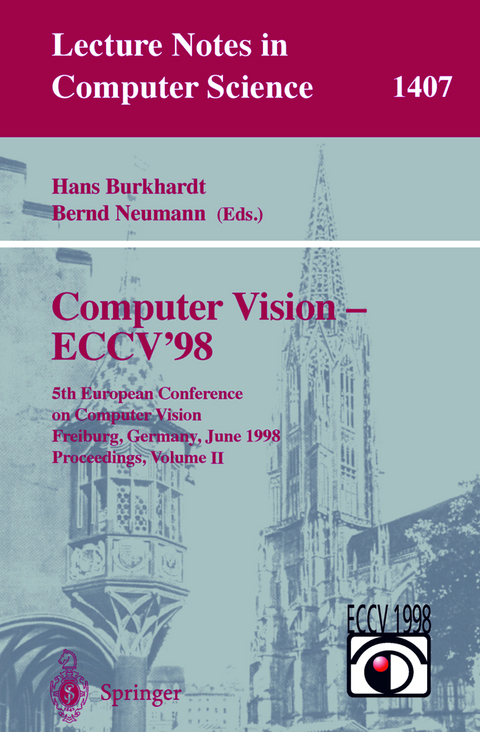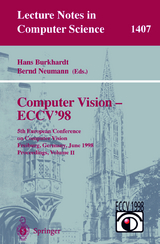Computer Vision - ECCV'98
Springer Berlin (Verlag)
978-3-540-64613-6 (ISBN)
Matching hierarchical structures using association graphs.- Stereo matching with implicit detection of occlusions.- A solution for the registration of multiple 3D point sets using unit quaternions.- Robust registration of dissimilar single and multimodal images.- Decoupling Fourier components of dynamic image sequences: A theory of signal separation, image segmentation, and optical flow estimation.- Spatiotemporally adaptive estimation and segmentation of OF-fields.- Robust video mosaicing through topology inference and local to global alignment.- Flexible syntactic matching of curves.- Holistic matching.- Creaseness from level set extrinsic curvature.- Multichannel shape from shading techniques for moving specular surfaces.- Modelling objects having quadric surfaces incorporating geometric constraints.- Surface reconstruction with multiresolution discontinuity analysis.- Shape from Chebyshev nets.- Changes in surface convexity and topology caused by distortions of stereoscopic visualspace.- Reconstruction of smooth surfaces with arbitrary topology adaptive splines.- (Mis?)-Using DRT for generation of natural language text from image sequences.- The structure of the optic flow field.- Optical flow using overlapped basis functions for solving global motion problems.- The role of total least squares in motion analysis.- Study of dynamical processes with tensor-based spatiotemporal image processing techniques.- Motion recovery from image sequences: Discrete viewpoint vs. differential viewpoint.- Discrete wavelet analysis: A new framework for fast optic flow computation.- Automatic detection and labelling of the human cortical folds in magnetic resonance data sets.- Efficient 3-D scene visualization by image extrapolation.- What shadows reveal about object structure.- Shape representations from shading primitives.- A comparison of measures for detecting natural shapes in cluttered backgrounds.- Bias-variance tradeoff for adaptive surface meshes.- Recognizing 3-D objects with linear support vector machines.- Active appearance models.- Estimating coloured 3D face models from single images: An example based approach.- A comparison of active shape model and scale decomposition based features for visual speech recognition.- Motion segmentation and depth ordering based on morphological segmentation.- Image sequence restoration: A PDE based coupled method for image restoration and motion segmentation.- Joint estimation-segmentation of optic flow.- Face recognition using active appearance models.- Face recognition using Evolutionary Pursuit.- Recognizing faces by weakly orthogonalizing against perturbations.- A probabilistic approach to object recognition using local photometry and global geometry.- Hypothesis verification in model-based object recognition with a gaussian error model.- Continuous audio-visual speech recognition.- Finding surface correspondence for object recognition and registration using pairwise geometric histograms.- Integrating iconic and structured matching.- Combining multiple views and temporal associations for 3-D object recognition.- Model-based recognition of 3D objects from one view.- A two-stage probabilistic approach for object recognition.- Combining geometric and probabilistic structure for active recognition of 3D objects.- Spatial dependence in the observation of visual contours.- Handling uncertainty in 3D object recognition using Bayesian networks.- Optimal robot self-localization and reliability evaluation.- Mobile robot localisation using active vision.- From reference frames to reference planes: Multi-view parallax geometry and applications.- Duality, rigidity and planar parallax.- On degeneracy of linear reconstruction from three views: Linear line complex and applications.
| Erscheint lt. Verlag | 26.5.1998 |
|---|---|
| Reihe/Serie | Lecture Notes in Computer Science |
| Zusatzinfo | XXXII, 884 p. |
| Verlagsort | Berlin |
| Sprache | englisch |
| Maße | 155 x 235 mm |
| Gewicht | 1263 g |
| Themenwelt | Informatik ► Grafik / Design ► Digitale Bildverarbeitung |
| Mathematik / Informatik ► Informatik ► Software Entwicklung | |
| Informatik ► Theorie / Studium ► Künstliche Intelligenz / Robotik | |
| Schlagworte | 3-D Vision • Active appearance model • Audio • Bildverarbeitung • Computational Geometry • computer vision • Computervision • Hardcover, Softcover / Informatik, EDV/Informatik • HC/Informatik, EDV/Informatik • Image Processing • Image Segmentation • Multiple-View Geometry • Mustererkennung • Object recognition • optical flow • Processing • robot • Segmentation • Text • Video |
| ISBN-10 | 3-540-64613-2 / 3540646132 |
| ISBN-13 | 978-3-540-64613-6 / 9783540646136 |
| Zustand | Neuware |
| Informationen gemäß Produktsicherheitsverordnung (GPSR) | |
| Haben Sie eine Frage zum Produkt? |
aus dem Bereich




